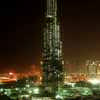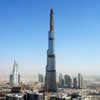Burj Dubai Tower, Emaar Properties, UAE skyscraper construction images, Architect info, Storeys
Burj Dubai Building : World’s Tallest Skyscraper
Tallest building in the world – UAE tower design by SOM for Emaar Properties
post updated 31 August 2021 ; 21 Jul 2007
The Burj Dubai surpasses Taipei as tallest building in the world
Adrian Smith + Skidmore, Owings & Merrill
Burj Dubai Skyscraper – World’s Tallest Building : Burj Khalifa status ratified – Mar 2010
Press Release : Burj Dubai reaches a record high
Burj Dubai
512.1m (1,680 ft) – 141 storeys, Burj Dubai is tallest building in the world
A human achievement without equal, says Emaar Chairman Alabbar.
Dubai, UAE; July 21, 2007: Today the world has a new global landmark – Burj Dubai. At 512.1 metres (1,680 ft), Burj Dubai, developed by Emaar Properties, is the tallest building in the world. The achievement once again puts Dubai in the international spotlight and underlines Emaar’s arrival as a global developer.
Now a Financial Times Global 500 (FT Global 500) company, Emaar has a significant presence in 30 international markets.
Burj Dubai is now taller than Taipei 101 in Taiwan, which at 508 metres* (1,667 ft) has held the tallest-building-in-the-world title since it opened in 2004. Burj Dubai has now reached 141 storeys – more storeys than any other building in the world.
On schedule for completion in 2008, Burj Dubai will be the tallest structure in the world in all four of the criteria listed by the Council on Tall Buildings and Urban Habitat (CTBUH). The council measures height to the structural top, the highest occupied floor, to the top of the roof, and to the tip of the spire, pinnacle, antenna, mast or flag pole.
During its construction, Burj Dubai has left behind the skyscrapers that previously defined tall tower architecture around the world, such as Petronas Towers in Malaysia (452 metres, 1,483 ft); Sears Tower, Chicago (442 metres, 1,451 ft); Jin Mao Building, Shanghai (421 metres, 1,381 ft) and Empire State Building, New York (381 metres, 1,250 ft).
The Burj Dubai story is only beginning. The final height and number of storeys, a topic of enthusiastic debate among media and experts alike, has not yet been revealed. But from now on, the tower will set new records for its technical and architectural ingenuity.
When completed, Burj Dubai will have consumed 330,000 cubic meters of concrete, 39,000 metric tons of steel rebar and 142,000 sq m of glass – and 22 million man hours. The tower will have 56 elevators travelling at 1.75 to 10 metres/sec and double-decker observatory elevators that can carry 42 people at a time.
More than 313,700 cubic metres of reinforced concrete and 62,200 tonnes of reinforcing steel have been used in the tower’s construction so far. Burj Dubai has already set a new world record for vertical concrete pumping for a building by pumping to over 460 metres (1,509 ft). The previous record of 448 metres (1,470 ft) was held by Taipei 101.
Reflecting a no-compromise approach to safety, Burj Dubai has been designed to manage the effect of wind and seismic movements. High-strength concrete makes up the tower’s super-structure, which is supported by large reinforced concrete mats and piles. The 80,000 sq ft foundation slab and 50-metre deep piling are waterproofed and feature cathodic protection.
Burj Dubai became the tallest building in the world in just 1,276 days; excavation work started in January, 2004. More than 5,000 consultants and skilled construction workers are employed on site, and the world’s fastest high-capacity construction hoists, with a speed of up to 2 m/sec (120 metres/min), move men and materials.
Structural steel work for the tower will begin soon, and cladding work using a high-performance system has already started.
The primary cladding materials of reflective glazing, aluminium and textured stainless steel spandrel panels and vertical stainless tubular fins accentuate the tower’s height and slenderness to the eye.
“Four years ago Burj Dubai was conceived by Emaar Properties as a 90-storey structure. It was the UAE Vice President and Prime Minister and Ruler of Dubai, His Highness Sheikh Mohammed Bin Rashid Al Maktoum, who inspired us to ‘resist the usual’ and build a global icon,” said Mr Mohamed Ali Alabbar, Chairman, Emaar Properties.
He said: “Burj Dubai is not just an architectural and engineering masterpiece in concrete, steel and glass. It is a human achievement without equal. Burj Dubai will inspire future generations to think beyond the ordinary and to challenge their mind and spirit.”
Emaar Properties has partnered with best-in-class consultants such as South Korean construction major Samsung Corporation and New York-based Project Manager Turner Construction to realise the design of internationally admired architect Adrian Smith and Skidmore, Owings & Merrill of Chicago.
Burj Dubai will be at the centre of Downtown Burj Dubai, a US$20 billion, 500-acre downtown development billed as the most prestigious square kilometre on earth.
Burj Dubai will feature residential, commercial and retail components including the world’s first Armani Hotel & Residences, exclusive corporate suites, a business centre, four luxurious pools and spas, an observation platform on Level 124 and 150,000 sq ft of fitness facilities.
Burj Dubai images / information from Edelman 210707 for Emaar Properties
*Note: All figures on the height of various towers as listed by the Council on Tall Buildings and Urban Habitat, Chicago
Burj Dubai Facts
Feb 2003: Emaar Properties announces Burj Dubai
Jan 2004: Excavation work for Burj Dubai begins
Jun 2004: Launches Downtown Burj Dubai
Sep 2004: UAE Vice President & Prime Minister and Ruler of Dubai His Highness Sheikh Mohammed Bin Rashid Al Maktoum witnesses the first pouring of cement for Burj Dubai
May 2005: Inks deal with Giorgio Armani to open The Armani Hotel & Residences in Burj Dubai
Jun 2006: Burj Dubai scales 50 levels
Jan 2007: Burj Dubai reaches Level 100
Mar 2007: Burj Dubai, at Level 110, is the tallest structure in the Middle East and Europe
Apr 2007: At Level 120, Burj Dubai sets new global record for having more floors than any building in the world
May 2007: At Level 130, Burj Dubai is second tallest tower in the world
Jul 2007: At Level 141, Burj Dubai is tallest tower in the world
Jan 2010 : Burj Dubai renamed Burj Khalifa + inauguration of the world’s tallest building
Burj Dubai Highlights
The tip of the spire can be seen by a person 95 km (60 miles) away.
An estimated 330,000 sq m of cement, 39,000 metric tones of steel rebar and 142,000 sq m of glass will be utilized in the construction of Burj Dubai.
22 million man hours will go into building the landmark.
The foundation slab is 80,000 sq ft in size and the piling is 50 metres deep.
Burj Dubai will set a new global record in vertical concrete pumping in any construction activity.
The Burj Dubai’s Observatory Elevators (double deck cabs) will have the world’s longest travel distance from lowest to highest stop.
Burj Dubai will contain the world’s highest elevator installation.
A Condensate Collection System will collect condensed water from the hot and humid air, which will be used for irrigation requirements for the tower’s gardens. This system will provide about 15 million gallons of supplemental water per year, equivalent to nearly 20 Olympic-sized swimming pools.
The curtain wall of the Burj Dubai will be equivalent to 17 football (soccer) fields or 25 American football fields.
The concrete used for the Burj Dubai is equivalent to a sidewalk 1,900 km long (1,200 miles).
Burj Dubai tower : main page with more images
Burj Dubai renamed to Burj Khalifa
Burj Dubai designer : SOM Architects
Burj Dubai Developers – Emaar Properties PJSC
Emaar Properties PJSC is one of the world’s largest real estate companies and is rapidly evolving to become a global provider of premier lifestyles. Powered by its Vision 2010 to become one of the most valuable companies in the world, Emaar is charting a new course of growth with a two-pronged strategy of geographical expansion and business segmentation.
Emaar has highlighted its remarkable global growth by debuting on the Financial Times Global 500 ranking, which provides an annual snapshot of the world’s largest companies. Emaar has been assigned A- and A3 ratings with stable outlook by Standard & Poor’s and Moody’s Investor Services, respectively.
Replicating its successful business model in Dubai, Emaar is extending its expertise in creating master-planned communities to international markets. Emaar is also developing new competencies in retail, hospitality and leisure, education, healthcare, finance and industry, which have evolved from its integrated approach to customer service and property development.
Listed on the Dubai Financial Market, part of the Dow Jones Arabia Titans Index and certified to ISO9001:2000 for quality standards, Emaar is developing Burj Dubai, the world’s tallest tower , and The Dubai Mall, one of the world’s largest shopping and entertainment destinations. In Saudi Arabia, Emaar is developing the US$26.6 billion King Abdullah Economic City, the region’s largest private sector-led project. Emaar’s portfolio currently covers the following countries: the UAE, Saudi Arabia, Jordan, Syria, Lebanon, Morocco, Egypt, Turkey, Libya, India, Pakistan, Indonesia, the US, the UK, France and Canada.
An award-winning developer, Emaar has strengthened its product sale competencies, market reach and best practices through strategic acquisitions and joint ventures. Emaar acquired John Laing Homes, America’s second largest privately held home builder; Hamptons International, UK’s premier realtor; and formed a joint venture with US-based Turner International to strengthen execution capabilities.
Emaar has joined hands with Giorgio Armani and Accor Hotels to strengthen its presence in hospitality, and will launch ten luxury Armani resorts and hotels world-wide and 100 Formule 1 budget hotels in India. The company is opening educational institutions and healthcare centres in South Asia, Middle East and North Africa and the Subcontinent. Emaar acquired Singapore-based leading education provider, Raffles Campus, to extend expertise to its educational institutions.
Emaar holds 30 per cent equity in Dubai Bank, focused on retail and commercial banking. Emaar is also the largest shareholder in Amlak Finance, UAE’s leading Islamic home financing company.
Burj Dubai
2005-
SOM Architects
160 storey tower for Emaar
due to become world’s tallest building in 2007, already tallest building in Middle East, eventual height shrouded in mystery: World Skyscrapers
Location: Dubai, UAE
UAE Architecture
Dubai Architecture Designs – chronological list
Sheth Tower Iris Bay Dubai Skyscraper
The Emaar Towers, Dubai, UAE
2007-
Aedas
Gateway to Burj Dubai development :42 & 34 storeys high
UAE Architecture : Abu Dhabi Building
Adrian Smith + Gordon Gill Architects
2CDE UAE Tower design
Selected Buildings by SOM Architects
Buildings in the UAE area
Comments / photos for the Burj Dubai Skyscraper page welcome


